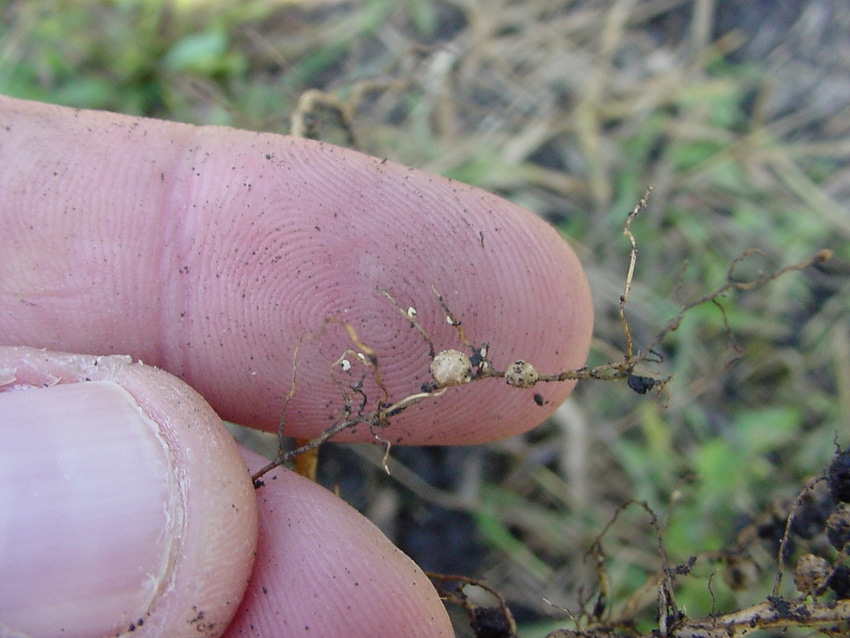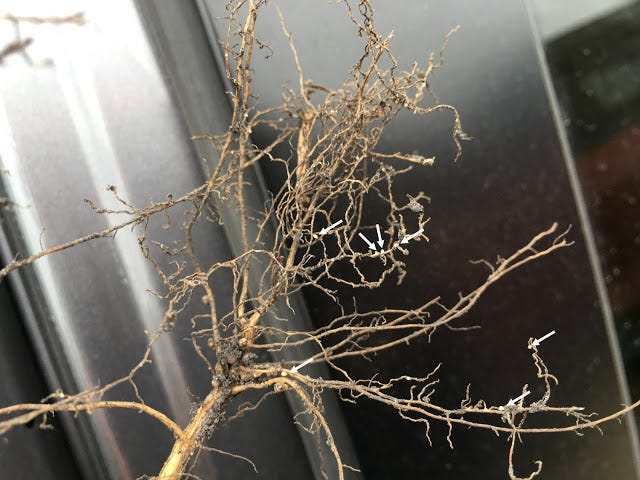October 24, 2018

Source: University of Minnesota Extension
By Angie Peltier, Jared Goplen and Phillip Glogoza, Extension educators
Now is crunch time for row-crop producers: harvesting, hauling and drying the crop, fall tillage and perhaps fall fertilizer applications need to take place before the snow sticks around. With recent rain events leaving fields unfit for heavy machinery traffic now might be a perfect time to collect soil samples to monitor soybean cyst nematode (SCN).
SCN is the top yield-limiting soybean pathogen and can cause up to 30% yield loss without obvious symptoms. Recently some SCN populations have shifted to overcome the most commonly available source of varietal resistance (called PI88788) resulting in higher SCN egg counts and yield losses. Knowing your SCN numbers is an essential component of an integrated SCN management strategy.
Collecting a soil sample for a first detection
SCN is most likely to first move into a field by hitching a ride on equipment or in water or wind-blown soil. If you don’t yet know whether a field is infested with SCN, focus on collecting soil cores from field entrances, low and frequently flooded spots, high pH spots and areas of the field where soybeans have lower than anticipated yields or mature earlier than expected. Collect 15 to 20 cores (1 inch diameter, 6 to 8 inches deep) in the soybean row where there are more roots and populations will tend to be higher and therefore detectable (Figure).

Figure. SCN cysts (white arrow) were easily observed at a UMN Extension soybean plot tour this summer.
Knowing your numbers in fields already known to be infested
Relying on simply knowing that a field is infested with SCN is not enough. Periodic SCN soil sampling is still needed to know whether populations are being well managed. Tracking general SCN population trends over years will help indicate whether varietal resistance is holding or beginning to decline.
Here are the University of Minnesota Extension’s SCN Management Guide’s sampling recommendations:
Divide a larger field into smaller 5 to 10 acre areas.
Collect soil cores from about 20 different locations in a zig-zag pattern for each area to be sampled, using a 1-inch-diameter soil probe to a depth of 6 to 8 inches.
Mix the soil sample thoroughly before putting about 2 cups in a sample bag labeled using a water-proof marker.
If samples cannot be sent within a few days to a professional laboratory for analysis store them at a cool temperature.
Check-off sponsored sampling program
This year Extension is partnering with the Minnesota Soybean Research & Promotion Council on a sampling program that will help you to “know your numbers”. The program will pay for laboratory analysis of soil samples and the lab will then provide to program participants results and management recommendations.
Fill out this online form to participate in this program and receive a sampling kit (quantity limited).
SCN management recommendations
1) Know your numbers! Relying on simply knowing that a field is infested with SCN is not enough. Periodic SCN soil sampling is still needed to know whether populations are being well managed. Tracking general SCN population trends over years will help indicate whether varietal resistance is holding or beginning to decline.
2) Plant non-host crops (small grains, corn, alfalfa, potato, sugar beet, canola, sunflower) to reduce a field’s SCN egg counts.
3) Plant SCN-resistant soybean varieties, rotating both within and among different sources of resistance. Because the PI88788 source of resistance has multiple genes that contribute to resistance, individual varieties may have fewer or more copies of these genes. Rotating to different varieties within the PI88788 source of resistance may expose SCN to different resistance genes.
Originally posted by the University of Minnesota Extension.
You May Also Like




